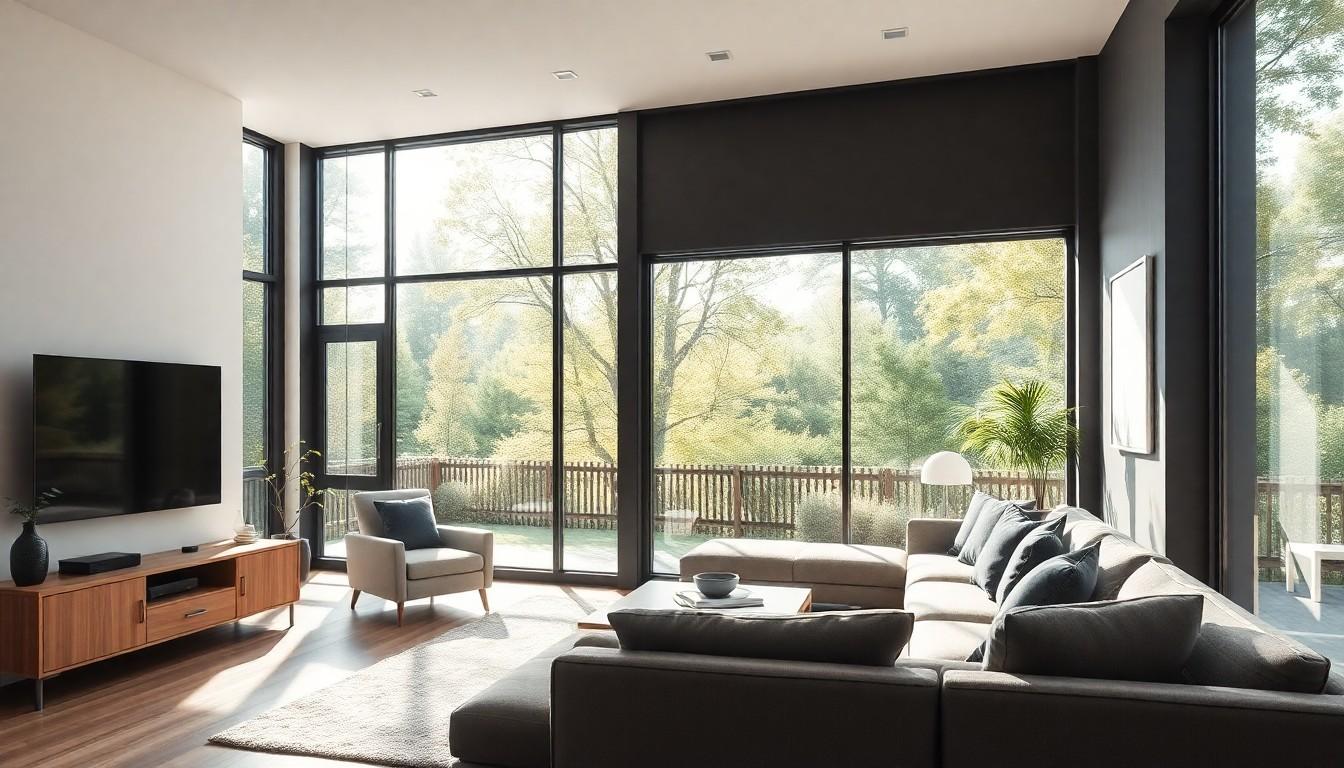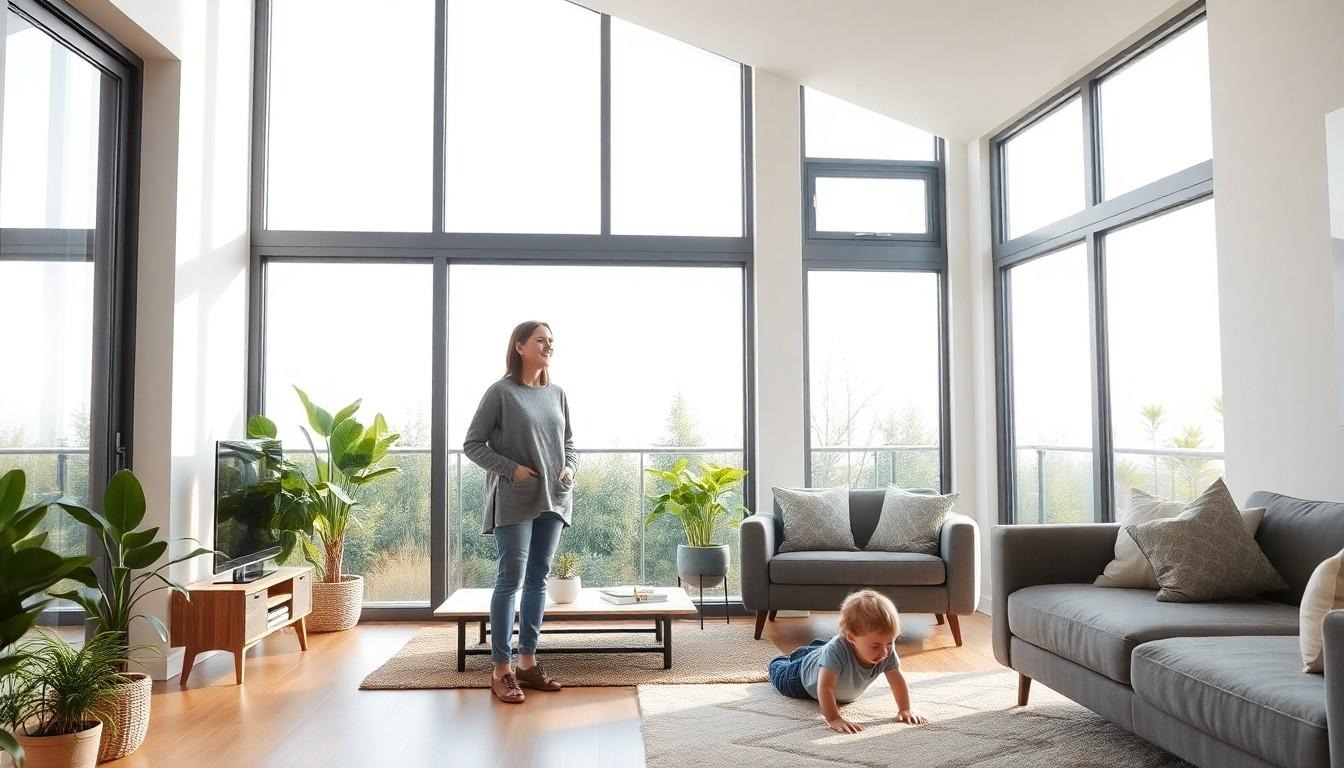Imagine a world where your windows not only let in sunlight but also adjust their tint to keep your home cozy and energy-efficient. Enter smart windows, the unsung heroes of modern homes. These high-tech marvels are more than just a pretty pane; they’re designed to enhance comfort while slashing energy bills. Who wouldn’t want to enjoy a sunny day without turning their living room into a sauna?
Smart Windows for Homes
Smart windows utilize advanced technology to enhance residential comfort and efficiency. These windows feature adjustable tinting that responds to external light conditions, providing homeowners with control over natural light and temperature. They can significantly lower energy consumption by minimizing reliance on heating and cooling systems.
Options for smart windows include electrochromic and photochromic technologies. Electrochromic windows change color based on electrical signals, whereas photochromic windows react to sunlight exposure. Homeowners experience benefits from both types through reduced glare and heat gain.
Integration with home automation systems sets smart windows apart. Homeowners can program windows to adjust automatically throughout the day, maximizing energy savings. Remote operation also offers convenience, allowing users to control settings from smartphones or tablets.
In addition to energy efficiency, smart windows enhance privacy and security. Tinted glass obscures visibility from outside during the day, contributing to a more secure environment. Advanced sensor technologies also notify homeowners of changes in their surroundings, adding another layer of protection.
The investment in smart windows yields long-term financial benefits. Studies indicate that they can reduce energy bills by up to 30 percent annually. Integrating these innovative features into modern homes pays off not only in comfort but also in sustainability and financial savings.
Benefits of Smart Windows

Smart windows offer numerous advantages that enhance home living. Their innovative features not only improve comfort but also contribute to energy savings.
Energy Efficiency
Smart windows significantly reduce energy consumption. By adjusting tint according to light conditions, they help maintain ideal indoor temperatures. Homeowners can experience energy bill reductions of up to 30 percent annually. The integration of smart windows with building automation systems optimizes their performance throughout the day. As a result, these windows minimize reliance on heating and cooling systems, further promoting sustainability.
Enhanced Comfort
Smart windows elevate comfort levels in living spaces. They regulate glare and heat gain efficiently, ensuring a pleasant atmosphere. Homeowners appreciate the ability to customize natural light levels, creating different moods in various rooms. The responsive nature of smart windows allows for real-time adjustments, enhancing the overall living experience. With advanced technology, these windows balance light intake and heat retention, making homes more enjoyable throughout different seasons.
Privacy and Security
Smart windows enhance both privacy and security for homeowners. They can obscure visibility from outside while allowing natural light to enter. Sensor technologies embedded in smart windows alert homeowners to unusual movements or disturbances. This added layer of security ensures peace of mind, especially during the night or when away from home. Smart windows not only provide a stylish option for modern aesthetics but also contribute to a safer living environment.
Types of Smart Windows
Smart windows fall into distinct categories, each offering unique functionalities and benefits. Understanding these types helps homeowners make informed decisions.
Electrochromic Windows
Electrochromic windows feature a layer of electrochromic material that changes tint in response to electrical signals. Such adjustments can occur with a simple switch or through automatic systems. During bright sunlight, these windows darken to reduce glare while providing privacy. This technology can optimize indoor lighting, resulting in a more comfortable living space. Energy efficiency improves, as less reliance on air conditioning reduces cooling costs. With potential annual savings of up to 30 percent on energy bills, choosing electrochromic windows proves advantageous for homeowners.
Photochromic Windows
Photochromic windows react to sunlight exposure, adjusting their tint based on the intensity of UV rays. This automatic response helps maintain consistent indoor brightness, minimizing glare throughout the day. As light levels change, the windows adapt, enhancing the comfort of the living environment. Homeowners benefit from a natural regulation of light and temperature without manual adjustments. These windows are particularly useful in sunny climates, as they naturally limit heat gain. Investing in photochromic windows can also contribute to long-term energy savings while improving overall home aesthetics.
Thermochromic Windows
Thermochromic windows employ materials that change color based on temperature variations. These windows darken in response to heat, effectively blocking infrared radiation while allowing visible light to pass through. Homeowners enjoy reduced heat gain during warmer months, leading to improved indoor comfort. This adaptability not only helps lower energy costs but also enhances the lifespan of HVAC systems. Unlike other smart windows, thermochromic options respond to temperature rather than light conditions alone. Implementing these windows offers a unique approach to climate control and energy efficiency within the home.
How Smart Windows Work
Smart windows leverage advanced technologies to adapt to varying light and temperature conditions, enhancing both comfort and energy efficiency in homes.
Technologies Involved
Electrochromic technology enables windows to tint based on electrical signals, offering homeowners control over light and heat levels. This type of window responds quickly to changing conditions, ensuring optimal indoor brightness. Photochromic windows automatically adjust to sunlight exposure, providing effective glare reduction. By reacting to UV rays, these glass panes maintain a balanced interior environment and reduce fading of furnishings. Thermochromic windows respond to temperature fluctuations, blocking infrared radiation that contributes to unwanted heat gain. These technologies collectively enhance energy savings, making smart windows an efficient choice for modern residential settings.
Control Systems
Smart windows operate using sophisticated control systems designed for customization and convenience. Home automation systems facilitate automatic adjustments throughout the day, optimizing light and temperature based on personal preferences. Remote operation through smartphones or tablets offers additional flexibility, allowing users to control window settings from any location. Integration with sensors further enhances functionality by adjusting the tint in real-time based on ambient light and outdoor temperature. These control systems not only simplify user experience but also support energy-efficient living by reducing reliance on traditional HVAC systems.
Considerations for Homeowners
Homeowners should evaluate key factors before investing in smart windows. Understanding installation, costs, and maintenance requirements ensures informed decisions.
Installation and Costs
Installation can vary based on window type and project scale. Electrochromic windows typically involve more complex setups, requiring professional installation. Costs range from $1,000 to $4,000 per window, factoring in materials and labor. Photochromic options are generally less expensive, with pricing starting around $500 per window. Additionally, potential incentives and rebates for energy-efficient upgrades might offset initial expenses. Budgeting for these variations is essential to gauge overall investment needs.
Maintenance Requirements
Maintenance of smart windows is generally minimal, focusing on cleanliness and system checks. Regular cleaning with non-abrasive solutions helps maintain clarity and functionality. Homeowners should periodically inspect electrical connections or sensors for wear. Most smart window technologies offer long lifespans, typically exceeding 20 years, but paying attention to any noticeable changes in performance remains crucial. Attention to warranty coverage also helps ensure long-term satisfaction and investment protection.

